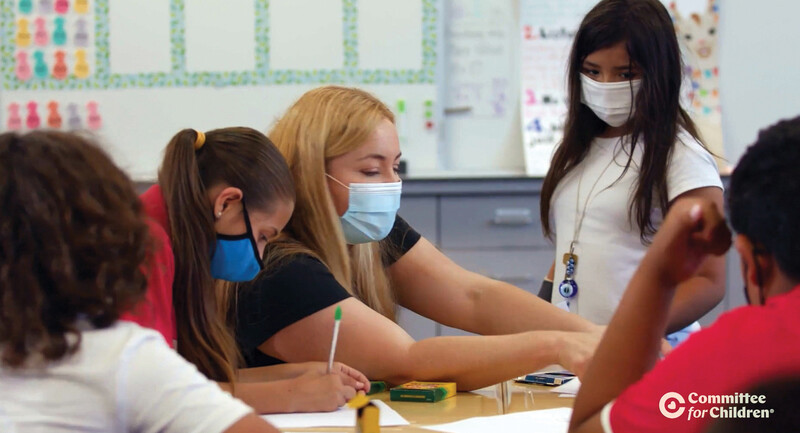The most effective teachers want to grow in their craft, and they often look to their principal for feedback and support. However, the more effective a teacher is, the harder it is for the principal to provide new and insightful feedback. Last year, I found myself facing that exact challenge. All the teachers on the faculty of Academy of the Pacific Rim's high school were effective, but they weren't growing. As the principal, I was conducting 20-minute mini-observations weekly or every other week and giving teachers feedback, but they continued to have the same strengths and weaknesses they had had for years. How could I push teachers in a manner that was authentic and that would have a lasting effect on instruction?
With this question in mind, I developed a new observation structure that would enable me to provide more in-depth and valid feedback. The result was an effective, collaborative observation experience that led to more successful teaching and learning.
The Weeklong Observation Structure
With the goal of helping good teachers get even better, I developed a weeklong observation structure that had two key components: an extended observation over the course of the week and a series of conferences between the teacher and me. The model has six steps:
Step One: The teacher selects a week in which the observer will watch him or her teaching the same class each day of the week for the entire duration of the class.
Step Two: Before the weeklong observation begins, the observer meets with the teacher to discuss the lesson plans and objectives for the week ahead. In addition, the teacher selects an area of focus for observation, and the observer also selects an area of focus on the basis of previous observations.
Step Three: The observer observes the teacher on Monday and Tuesday and provides written notes to the teacher each day.
Step Four: The teacher and the observer meet for a midweek conference to discuss the week so far. They examine the observer's written feedback together to ensure that both the teacher and the observer are on the same page. They make a plan for the rest of the week and adjust lesson plans as needed.
Step Five: The observer observes the same class for the rest of the week and continues to provide daily written feedback.
Step Six: The teacher and the observer meet for a post-observation conference. The observer provides written summative feedback on a template developed for this new structure. The template (available online at www.ascd.org/ASCD/pdf/journals/ed_lead/el_201012_colasacco_template.pdf) lists two areas of focus, one suggested by the teacher and the other by the observer. It provides space for feedback on those areas, as well as on the implementation of suggested changes, flow and cohesion of lessons throughout the week, use of varied instructional techniques, and evidence of student mastery. The teacher and observer analyze the areas of focus established in the pre-observation conference, the success of any changes that were implemented midweek, and the general flow of the week's lessons.
Observation in Action
So what does the new structure look like in practice? Take as an example my weeklong observation of a senior Advanced Placement (AP) Calculus class. The teacher was a veteran math teacher whose students had demonstrated excellent results on the 10th grade state assessments for six years running. In the pre-observation conference, we agreed that I would focus on classroom management and student engagement.
During Monday's class, I observed that not all the students were engaged in the material; only a few were asking and answering questions. It was impossible to know whether the nonparticipating students were mastering the material— more checks for understanding were needed. On my observation form, I suggested that the teacher have students put their answers to the problem sets on the board and then discuss them.
I went to class on Tuesday expecting to see a difference in class engagement. After students completed the problem sets at the beginning of class, the teacher asked students to put the answers on the board. However, the same students who had been calling out the answers on Monday now put multiple problems on the board and argued with one another about the answers. The quiet students still did not participate, and the teacher's attention was directed even more to the louder students up at the board. This was not how I had expected the teacher to implement my suggestion, but my written feedback alone had not provided enough guidance.
The next morning, I met with the teacher for our midweek observation. We discussed the suggestion, and I was clearer and more direct, telling him to call on each student to put one problem on the board and explain it out loud, while the rest of the class listened and took notes, comparing their answers to this one. Then the student at the board was to answer questions from classmates. This way, all students would have the opportunity to answer questions, and the teacher would be checking for understanding among all of his students. The teacher, who had been discouraged that my suggestion didn't seem to help, agreed to try again, following these additional guidelines.
I observed that afternoon, and the lesson was much more effective. Every student had to demonstrate understanding of the material. At the end of class, the teacher remarked, "Now I see what you mean. This was good—I will do it from now on." Although the change was relatively minor, the positive effect it had on the teacher's ability to assess his students' understanding was significant. Without the structure in place to observe on consecutive days, I would not have known that the teacher misunderstood my suggestion, and the teacher would not have had the chance to try again right away. His instruction would not have changed in the long term.
Challenges
With the new model and all of its benefits, some challenges remained. The surprise element of the informal unscheduled mini-observation was gone. Although many educators believe that an unannounced visit is the most likely to lead to an accurate understanding of the classroom, I could not visit the same class each day and maintain an element of surprise.
Additionally, it was sometimes a struggle to stick to the structure. If I was supposed to be observing freshman history Wednesday at 9:00 a.m. and an emergency came up, I would have to cancel the observation. The interruption to the week's observations decreased the structure's effectiveness.
Finally, I rarely had time for the ongoing mini-observations that had kept me in touch with teachers in the past. Under the new system, a teacher may be observed every day for a week in December, but not again until April. The momentum we built throughout the week in December sometimes got lost in the interim months.
The Results
Despite these challenges, it soon became clear that the benefits outweighed any drawbacks. Through this structure, I was able to observe and analyze instruction on a much deeper level than before. Because I had a conference with the teacher before the week began, I knew the goals and objectives for the week's instruction. Now, I was able to observe multiple lessons designed to meet these goals. For the first time, I was able to see how a series of lessons fit together; I had never been able to give feedback regarding cohesion and flow on this level.
Additionally, I could make suggestions and observe changes as they were implemented. Were my ideas valid and effective? Was the teacher implementing them as I had intended? Did the teacher feel they were effective? Seeing the same group of students in the same class throughout the week also enabled me to collect more data on the students' responses to the teacher's instructional and classroom management strategies. Using this data, the teacher and I could collaboratively plan for improvement.
Faculty Response
Looking for faculty feedback on the new system, I distributed an anonymous survey asking faculty to compare the new observation structure with the old. The results were overwhelmingly positive: 9 out of 10 classroom teachers reported that they found my feedback from the weeklong observations more useful and accurate. They said that they were at least 25 percent more likely to implement suggestions under the new structure. One teacher wrote, "I love the new observation structure! I feel like Jenne really sees what is going on in my classroom." Another stated, "I am more likely to take the time to do the work to implement changes when I know that Jenne is coming in the next day."
Faculty members in general indicated they felt supported, pushed, and validated. They also felt respected and valued because of the amount of time I spent observing. As the principal, I had a much more authentic idea of what was happening in classrooms, and I was achieving my initial goal of helping effective teachers improve.
Next Steps
This year, I am continuing to use the weeklong observation structure with some changes that I hope will address the challenges related to the new structure. I am dividing the teachers on the faculty into two tiers. In the first tier are teachers who need frequent mini-observations, either because they are new and need more consistent, ongoing feedback or because they are struggling and need more regular support. In the second tier are the majority of teachers in my school—those who are effective but could benefit from the in-depth feedback of the weeklong observation. I will also spend a week each trimester doing mini-observations of everyone to ensure that two or three months do not pass without my seeing each teacher in action in his or her classroom.
Applying the Model
Principals and instructional leaders in any setting can use the weeklong structure to provide more in-depth feedback to teachers. In a small school like mine, with only 12 teachers, a principal can observe each teacher for multiple weeks each year.
In a school with a larger faculty, the principal might not be able to use the model schoolwide, but it's still possible to use it in a targeted way by selecting a few teachers each year to observe— perhaps a teacher who is stalled with a particular aspect of teaching or those teachers for whom the principal feels least able to give meaningful feedback. Alternatively, principals in larger schools could provide substitutes for department chairs, enabling these teacher leaders to observe their department members using this structure.
Regardless of the scale of the implementation, I believe this model has the potential to help instructional leaders gain a better and more authentic understanding of the instruction happening in their school.









